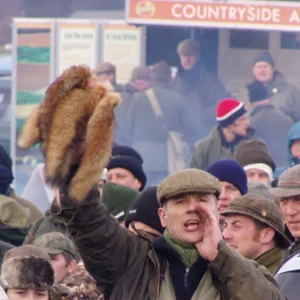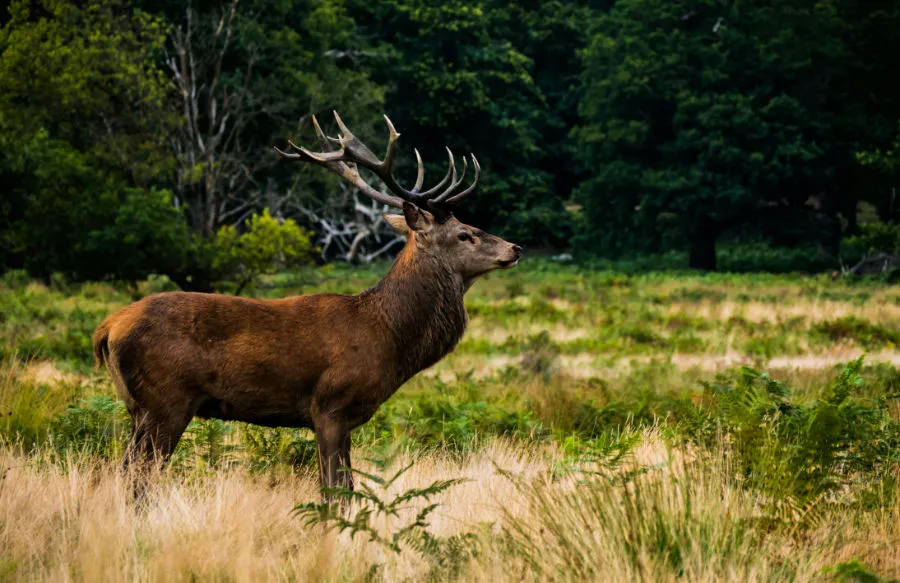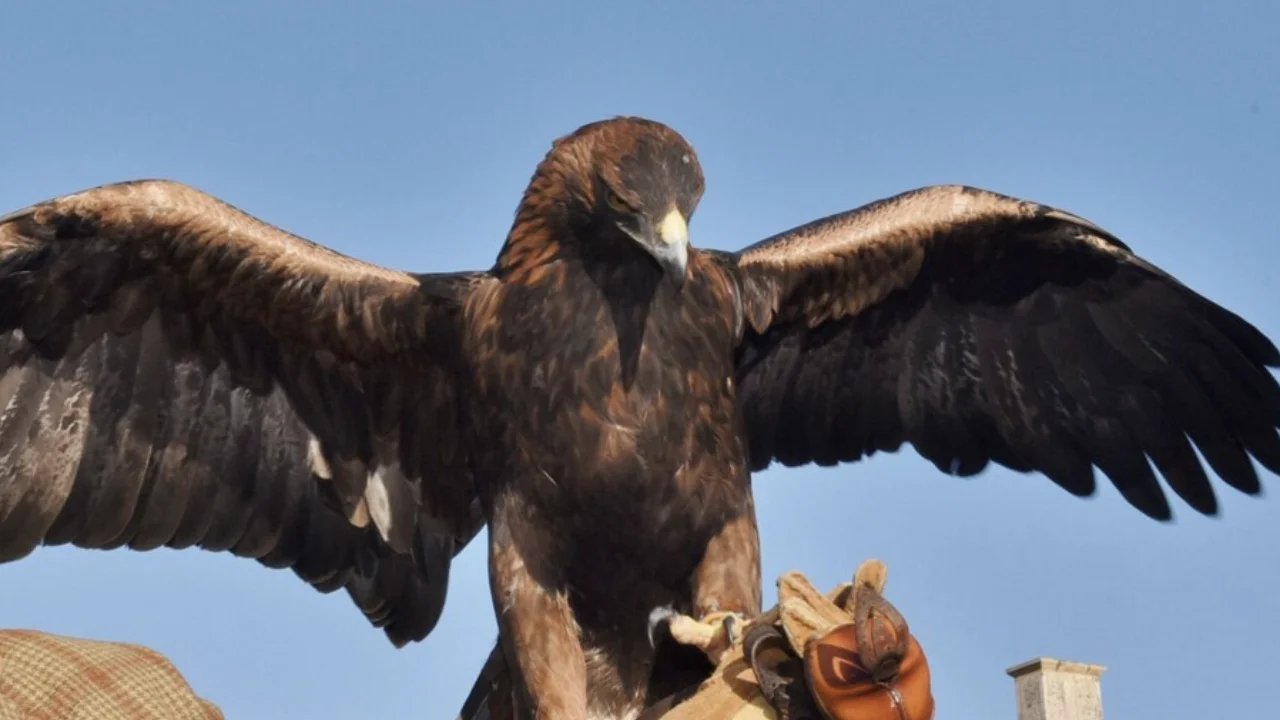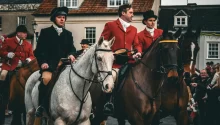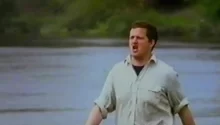Applying the Animal Welfare Act 2006 to Stag Hunts: Exploring Temporary Control Under Section 2(B).
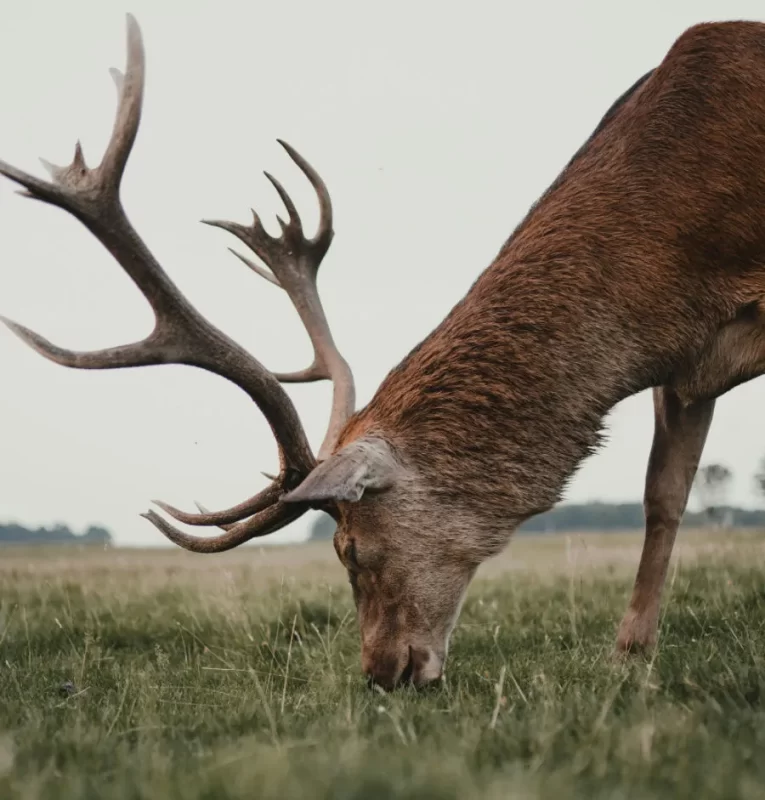
Introduction
For years Stag hunts have operated precariously on the boundary between exempt and non- exempt activities under the Hunting Act 2004. However, in recent times, substantial evidence has emerged indicating that the exemptions provided by the Hunting Act 2004, particularly those related to research and observation under Schedule 1, are being misused. Despite this, hunts continue to operate under these exemptions, leading many to argue that these practices merely exploit the exemptions to circumvent an offence under Section 1 of the Hunting Act 2004. (Egret, E (2022) The brutal reality of stag hunting. Protect the Wild) Consequently, if the Hunting Act 2004 is indeed being exploited, what alternative legislation could be reasonably employed to curtail such hunting activities and ensure that legal consequences are enforced?
This article aims to explore the potential application of the Animal Welfare Act 2006, with a specific focus on Section 2 (b) and the concept of temporary control.
Animal Welfare Act 2006
Under the Animal Welfare Act 2006 the Acts focus is on responsible animal ownership and the prevention of harm to animals by way of ‘unnecessary suffering’. The Act created welfare offences for failing to provide adequate care for an animal. And covers events of neglect with companion animals in particular.
Under the Animal Welfare Act 2006, as amended in 2021, the maximum penalties for animal welfare offences are:
For offences relating to the duty of care to an animal, the maximum penalty is a fine up to £20,000 and/or imprisonment for up to six months.
For offences relating to causing unnecessary suffering, the maximum penalty is an unlimited fine and/or imprisonment for up to five years.
Offences under the Animal Welfare Act 2006 are Either-way and can be heard either in the Magistrates or Crown Courts.
In comparison to the Hunting Act 2004 the maximum penalties for an offence under Section 1 are:
A fine not exceeding level 5 on the standard scale
Hunting Act offences are Summary only and can only be heard in the Magistrates Court. (The Hunting Act 2004, S 1)
For an offence under the Animal Welfare Act 2006, an animal must be a ‘protected animal’ under Section 2.
A protected animal under the Act extends solely to domestic animals, for example, pets and those in the temporary or permanent control of a person. (Section 2, Animal Welfare Act 2006)
Under Section 2 of the Animal Welfare Act 2006 for an animal to be a “protected animal” for the purposes of this Act-
a) It is of a kind which is commonly domesticated in the British Island.
b) It is under the control of a man whether on a permanent or temporary basis, or
c) It is not living in a wild state.
What is important for the purposes of this article is Section 2 (b), the definition under Section 2(b) covers temporary or permanent human control, this could include keeping a wild animal for a short period of time. The extent of this definition is intended to be a broader expression than “captive animal” which had been used in an equivalent context under the Protection of Animals Act 1911. (Animal Welfare Act 2006, Explanatory Notes, Section 2, “Protected Animal”)
Being in charge of an animal on a temporary basis could be interpreted in the general sense and taken to mean how it is written, Therefore, it would cover such situations as a dog being held in an animal sanctuary or by a friend whilst the dog owner is in hospital. (Collinson, A. (2018) Legal protection for animals in the UK. Michigan State University College of Law)
The next aspect to consider in this article is the concept of “unnecessary suffering.” Should hunts be found in violation of the Animal Welfare Act 2006, it could be argued that Section 4 would be particularly pertinent, as it addresses the element of unnecessary suffering on an animal, especially in the context of “sport.”
Section 4 of the act creates an offence of “unnecessary suffering” in that:
(1) A person commits an offence if-
(a) An act of his, or failure of his act, causes an animal to suffer,
(b) He knew, or ought reasonably to have known, that the act, or failure to act, would have that effect or be likely to do so,
(c) The animal is a protected animal, and
(d) The suffering is unnecessary.
Taking each in turn, Section 4 (1) (a) could be situations in which a huntsman had failed to act when his hounds were pursuing a stag till exhaustion or if his hounds had attacked a stag without the huntsman stopping this. However, it is important to note that stag hunts do not use the hounds to kill the stag therefore, these are purely isolated hypotheticals. An offence of unnecessary suffering does not just extent to a physical act but also includes a mental element of unnecessary suffering. (Section 62 (1) Animal Welfare Act 2006)
Section 4 (1) (b) relates to the conduct of a person for example the huntsman should have ought to have known or could be expected to know that an animal would suffer as a result of his conduct. This introduces an objective mental element to the offence. It is not necessary to prove that a defendant actually knew his act or failure to act would cause suffering.
Section 4 (1) (c) has already been addressed above.
Section 4 (1) (d) does not have a clear definition however, Section 4 (3) does provide light on
what considerations are relevant to have regard when determining whether suffering is
unnecessary, examples include:
(a) Whether the suffering could reasonably have been avoided or reduced;
(b) Whether the conduct which caused the suffering was in compliance with any relevant
enactment or any relevant provisions of a licence or code of practice issued under an
enactment;
(c) Whether the conduct which caused the suffering was a legitimate purpose such as –
(i) The purpose of benefiting the animal, or
(ii) The purpose of protecting a person, property or another animal;
(d) Whether the suffering was proportionate to the purpose of the conduct concerned;
(e) Whether the conduct concerned was in all the circumstances that of a reasonably
competent and humane person. (Section 4, Animal Welfare Act 2006)
The considerations focus on the necessity, proportionality, humanity and competence of the
conduct. The court will take all considerations into account, weighting them against each
other. (Animal Welfare Act 2006, Explanatory notes, Section 4)
In considering Section 4 (1) (e) and the reasonableness of the defendant’s conduct, the case of Hall v RSPCA and RSPCA v Issacs is significant. In this case, pig farmers who failed to seek veterinary care for their arthritic pigs had their convictions upheld by the Divisional Court, as there was insufficient evidence to demonstrate that a reasonably competent and humane pig farmer would have acted similarly. (Hall v RSPCA [1993] QBD, RSPCA v Issacs [1994] Crim LR 517) In the context of a hunt master, who, by virtue of their knowledge and expertise, should recognise that pursuing a stag for hours until exhaustion could potentially cause unnecessary suffering, this principle is especially relevant. This case predates the Animal Welfare Act 2006; however, the guidance remains relevant. Although it is important to state that a court will on all the facts establish whether or not unnecessary suffering was caused.
Relevance to stag hunting
When analysing Section 2 (b) of the Animal Welfare Act 2006, it is reasonable to suggest that it may not apply to wild stags in the context of stalking and flushing under Schedule 1 of the Hunting Act 2004. However, it could be relevant to captured stags if it can be demonstrated that the stag was temporarily under the control of the huntsman. This could be evidenced by the use of hounds in pursuit of the stag over several hours, as well as by showing that the stag was being driven in a specific direction by the huntsman and the hounds. (Mendip Hunt Sabs, “No kill for QSH Closing meet” Facebook, 24/4)
Moreover, if the stag was cornered and unable to flee, this could further indicate that the animal was temporarily under the huntsman’s control. It is also fair to suggest that control could extend to the fact that even over a very large area of land the stag would still have no realistic prospect of escape. (“Stag Hunting: A marathon of cruelty”, Hunt Saboteurs Association (2024))
While not typically observed during stag hunts, it is worth considering the offence of animal fighting under Section 8 of the Animal Welfare Act 2006, despite the fact that stag hunts do not use hounds to kill the stag. Animal fighting is defined as “an occasion on which a protected animal is placed with another animal, or with a human, for the purpose of fighting, wrestling, or baiting” (Advocates for Animals, “Stag Hunting – Legal Overview and Potential Challenges”). This could become relevant during or at the conclusion of a stag hunt. The pertinent case law is Royal Society for the Prevention of Cruelty to Animals v McCormick (2016). The judgment highlights key points that could be applicable to dogs hunting stags:
“Parliament’s intention was to outlaw fights, wrestling, or baiting that occur in contrived and/or artificial settings as a result of deliberate and intentional acts by a person placing them in such settings for entertainment and/or financial gain” (Royal Society for the Prevention of Cruelty to Animals v McCormick [2016] EWHC 928 (Admin) para 25).
It is reasonable to assert that the Animal Welfare Act 2006 was designed to prevent animals from being placed in artificial environments created by humans for the purposes of fighting and/or entertainment. Furthermore, since causing “unnecessary suffering” encompasses not only physical harm but also mental distress, it is not necessary for the dogs to have physically attacked an animal for the offence to be relevant.
Furthermore, the judgement goes on to say that
“There are in my judgment two key elements by reference to the assumed facts in order for an animal to be “placed with” another animal “for the purpose of fighting”, namely physical proximity and control:
(a) Proximity in the sense that the other animal must be immediately present. There is no
hunt or chase to find the other animal;
(b) Control in the sense that the other animal cannot escape. I accept that the fact that the paradigm example of an animal fight under section 8 may be one in a confined area does not itself determine that there is thus a requirement for confinement in all cases. But it seems to me that unless the other animal, say a deer, cannot escape, one is not “placing” the dog “with the deer”. Rather one is simply placing the dog in a field where there was a deer.” (Royal Society for the Prevention of Cruelty to Animals v McCormick [2016] EWHC 928 (Admin) para 32) For any successful case with the above in mind in relation to stag hunts it would be necessary for the courts to look at expanding the meaning of “control”. Moreover, as noted in the judgment, it is not always necessary for an animal to be physically confined. It could be fair to suggest that a stag forced to seek refuge in a river would constitute a form of control. (Mendip Hunt Sabs (2024) “stag killed in river” [Facebook] 24/8)
Figure 1 shows a stag in a river after being chased by the hunt, exhausted it seeks refuge, the footage shows the huntsman positioned behind the stag.
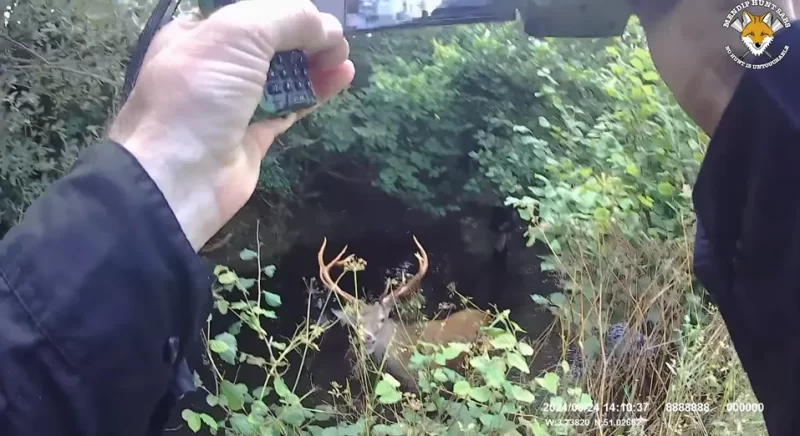
The concept of confinement can be interpreted broadly, encompassing not only scenarios where an animal is placed in a cage but also situations where it is restricted to a field with no possibility of escape. Initially, a stag might have the opportunity to escape, but as the hunt progresses and the stag becomes increasingly exhausted, it could find itself surrounded by the hounds, effectively eliminating any possibility of escape. At this point, it could be argued that the stag has become a captured animal. (Advocates for Animals, “Stag Hunting – Legal Overview and Potential Challenges”)
The judgement goes on to say:
“As for the example advanced by the RSPCA, namely of two dogs bred for fighting being placed together in an open field to fight, quite different considerations arise. If the dogs were encircled by onlookers so as to prevent escape, there would be no reason why such activity could not fall within section 8 of the Act.” (Royal Society for the Prevention of Cruelty to Animals v McCormick [2016] EWHC 928 (Admin) para 39)
This quote from the judgment is particularly intriguing, as it allows us to distinguish between the use of dogs for fighting and for hunting, with the stag as the target. In the context of hunting, the stag is often surrounded by hunters, their support teams, and hounds, leaving it with few options for escape. It is common to observe the stag eventually giving up before being shot. (Humphires, W (2022) “Hunters shoot exhausted stag after 3-hour pursuit with dogs”, The Times)
Conclusion
In conclusion, the potential application of the Animal Welfare Act 2006, particularly Section 2(b) concerning temporary control, offers a compelling legal avenue for addressing the issues surrounding stag hunts. While the Hunting Act 2004 provides specific exemptions that hunts have historically relied upon, evidence suggests that these exemptions are often
misused to circumvent the law. The Animal Welfare Act 2006, with its broader focus on preventing unnecessary suffering, could be instrumental in challenging such practices, especially when it can be demonstrated that a stag, although initially free, is eventually brought under the control of the huntsman and hounds, effectively becoming a captured animal. The interpretation of “control” in this context, as highlighted in the case of RSPCA v McCormick (2016), could be expanded to encompass scenarios where a stag is surrounded and deprived of any realistic chance of escape, thus falling within the scope of the Act’s protections. This approach not only reinforces the legislative intent behind the Animal Welfare Act 2006 but also provides a stronger legal framework for addressing the ethical concerns associated with stag hunting. However, for any concrete decision on the extent on the use of the Animal Welfare Act 2006 would need to be tested in court.
Photograph Credits
Top photograph by Henry Ravenscroft
Final photograph by Jamie Street
I would like to say a massive thank you to Mendip Hunt Sabs for permission to use their photo, selflessly taken in process of protecting our amazing animals.
REFERENCES
Egret, E (2022) The brutal reality of stag hunting. Protect the Wild Animal
Welfare Act 2006, Section 2
Animal Welfare Act 2006, Section 2 (b)
Animal Welfare Act 2006, Section 4
Animal Welfare Act 2006, Section 4 (1) (a)
Animal Welfare Act 2006, Section 4 (1) (b)
Animal Welfare Act 2006, Section 4 (1) (c)
Animal Welfare Act 2006, Section 4 (1) (d)
Animal Welfare Act 2006, Section 62 (1)
Animal Welfare Act 2006, Explanatory Notes, Section 2, “Protected Animal
Hall v RSPCA [1993] QBD, RSPCA v Issacs [1994] Crim LR 517
Mendip Hunt Sabs, “No kill for QSH Closing meet” Facebook, 24/4
Mendip Hunt Sabs (2024) “stag killed in river” [Facebook] 24/8
Humphires, W (2022) “Hunters shoot exhausted stag after 3-hour pursuit with dogs”, The Times“
Stag Hunting: A marathon of cruelty”, Hunt Saboteurs Association (2024)
Advocates for Animals, “Stag Hunting – Legal Overview and Potential Challenges
“Royal Society for the Prevention of Cruelty to Animals v McCormick [2016] EWHC 928
(Admin) para 25, 32, 39
The Hunting Act 2004, Section 1
The Hunting Act 2004, Schedule 1
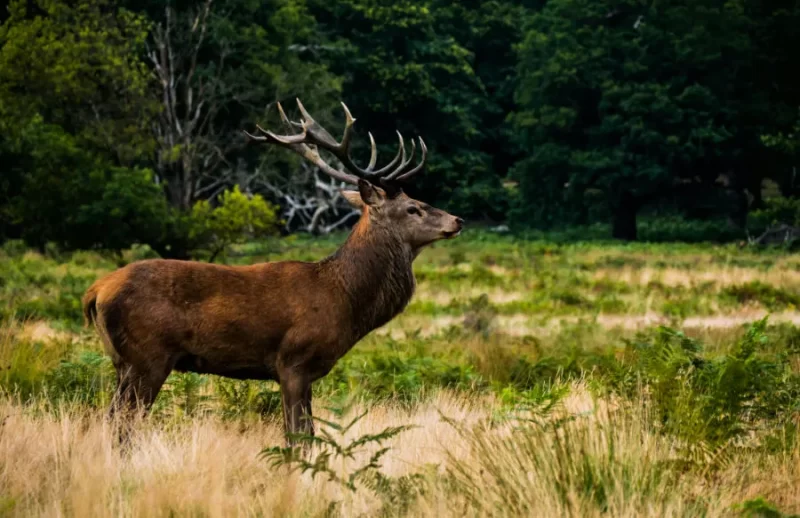
About the Author

James SF Hart provides legal analysis and commentary on issues related to fox hunting law and advocates for reform of the Hunting Act 2004.
Follow on social media


